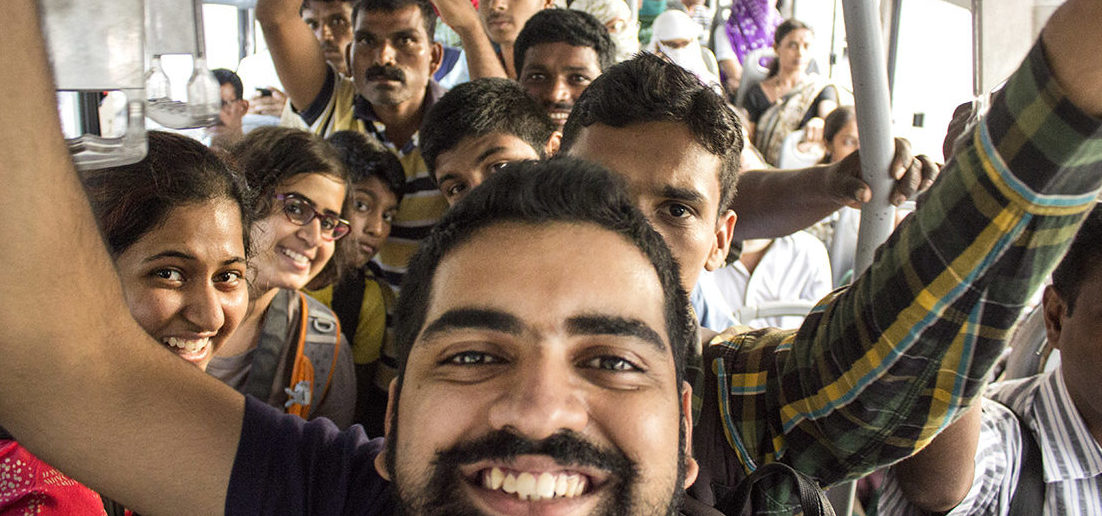Just months into operations, the Rainbow BRT in Pune and Pimpri-Chinchwad, India is moving a whopping 67,000 commuters per day and receiving widespread attention. The high ridership is proof of the comfort and convenience of the system, and surveys show that passengers feel safer taking the bus than before. On November 28, 2015, a new 8km, 14 station stretch of Rainbow BRT opened in Pimpri-Chinchwad, broadening access to the network. The dramatic success of Rainbow is part of why the system was recently awarded “Outstanding Contribution to Sustainable Mobility” at the Volvo Sustainable Mobility Awards 2015.
Since the launch of the first Rainbow BRT corridor in Pune on 30th August 2015, thousands of commuters have enjoyed high quality bus rides like never before. For the first time, citizens experienced the ease of use that comes with the system’s closed stations with sliding doors, level boarding, informative displays and transit maps. For passengers, the biggest incentive has been travel time savings. Dedicated bus lanes allow Rainbow buses to travel more quickly, ensuring that commuters reach their destinations 10 to 15 minutes earlier than usual.

For the first time, citizens experienced the ease of use that comes with the system’s closed stations with sliding doors, level boarding, informative displays and transit maps.
Thanks to the BRT’s high degree of reliability and convenience, a commuter shift was natural. Surveys carried out by the Institute for Transportation and Development Policy (ITDP) showed that 12 percent of Rainbow users switched from using other modes of transport besides bus, including two wheelers, para-transit, and even cars. Now, instead of taking personal vehicles, which contribute more to congestion and pollution, these commuters take public transit. These benefits speak to the achievement of the system, and validate the challenges it had to overcome to reach operations.
Rainbow BRT serves the neighbouring cities of Pune and Pimpri-Chinchwad. The two cities, with two different municipal governments, installed the BRT infrastructure with different funding sources. The processes, timelines, and aspirations of these two cities were different, and presented many planning challenges that needed to be coordinated to give users a seamless BRT experience.
For example, Pune attempted a pilot BRT system in 2006, and the new system planned to use the designs and practices of the pilot project, where possible. In contrast, Pimpri-Chinchwad was starting on a clean slate, and designing the entire system afresh. The differences in approach led to several design challenges— most notably, the choice of station design. While the Pune BRT pilot had used split stations, with platforms on both sides of the bus lanes, the Pimpri-Chinchwad BRT opted for median-aligned stations, as recommended by the BRT Standard. After many meetings and discussions with officials and media, Pune too was convinced to adopt median stations, a decision that was crucial for the success of Rainbow BRT.

Ms. Pranjali Deshpande, of ITDP India, and Mr. Rajan Patil, City Engineer of Pimpri Chinchwad Municipal Corporation accept the Volvo “Outstanding Achievement Award” for Rainbow from H.E. Mr. Harald Sandberg, Ambassador of Sweden to India.
The other big challenge in designing the system was ensuring good bus frequency and a reliable schedule. To help this process, ITDP undertook a massive exercise to analyze the pre-BRT ridership of all bus routes in the two cities at multiple different times, and along different sections of each route. Based on the study, ITDP recommended that PMPML, the systems bus operator, curtail, extend and/or merge some routes, resulting in all existing trips being supported with fewer routes and higher frequency. Load factor was improved where it was low and feeder routes were introduced to serve fringe areas. This improved reliability, a key factor in attracting high use of the bus system, and in helping riders reach home sooner.
On November 25, Rainbow received acclaim on the national stage for its success. At the Volvo Sustainable Mobility Awards, Rainbow was awarded for its ‘Outstanding Contribution to Sustainable Mobility’, in recognition of Rainbow’s role in reducing reliance on personal motorized vehicles and offering a true mass rapid transit system that provides high quality, rapid, predictable and reliable, safe and attractive public transport to the masses. Instituted in 2011 by Volvo Buses India, the Volvo Sustainable Mobility Awards aim to recognize outstanding efforts in the broad area of sustainable mobility.
Just three months after Rainbow opened, a new 8km stretch in Pimpri-Chichwad debuted November 28th. Since the recently opened corridors form only a fraction of the eventual 147 km network, the success of the system thus far will help ensure speedy implementation of the rest of the network, and more convenience for all.










